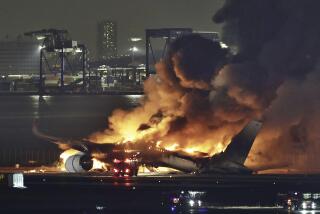More bad news for Germany: Berlin’s overdue airport could collapse
- Share via
BERLIN The good news from Berlin’s seemingly ill-fated and long overdue new airport is that the new tarmac has been pretty intensively cleared of any weeds.
The bad news is the reason for that: For the past week, construction crews working on the new main terminal (scheduled to open in June 2012) haven’t been allowed into the building they were working on because of fears that it might collapse.
It was the latest setback in a tough week for German engineering, which saw the CEO of its largest automobile manufacturer, Volkswagen, resign over revelations that the company had engineered a system to cheat on emissions tests rather than admit it couldn’t figure out how to comply U.S. pollution standards for diesel engines. At least 11 million cars worldwide were equipped with software that shut off the emissions control system, except when the cars were undergoing tests. More than 500,000 of those were sold in the United States.
The travails of the Berlin Brandenburg International Airport, three years behind schedule and not expected to be ready for, optimistically, another two to three years, already had been fodder for mocking commentators and comics. The new revelations just added to the humiliation, especially because the new scare was caused by engineers’ efforts to fix what had been a principal cause of past delays, a smoke removal scheme that was a flop.
Originally, architects had created the problem by trying to avoid marring the smooth lines of their terminal design with large funnels needed to move smoke skyward. So instead they decided to remove smoke by underground tunnels.
That notion, it turned out, ran counter to the laws of science. Smoke rises, and the tunnel scheme was worthless.
To fix that problem, large ventilating fans were added to the roof of the building.
Only, officials discovered after the fact that adding the fans pushed at least three of the terminal’s 20 roof panels past the weight they were designed to support at least twice the weight.
The problem was discovered during tests on whether the system was finally up and running.
The former planner of the smoke extraction system, Alfredo di Mauro, told the German newspaper Berliner Zeitung this week that his original plans were clear. He said his plans called for five ventilators weighing a maximum of 2 tons each.
The roof sections were designed to support 2 tons each. One is now holding up 4 tons.
Di Mauro told the newspaper that his plans warned that the roof construction was fragile, when compared to need. He said that later, after his plans were complete, metal shielding seems to have been added that increased the weight of the fans.
“If such a device crashed down, it has the impact of a bomb,” he told the newspaper. (An embarrassing side note: the contract with di Mauro’s company, PG BBI, was terminated in May 2012 when it turned out di Mauro was not, as officials thought, an engineer but a technical draftsman.)
Experts have told German media that the vibrations generated by the ventilators also greater than originally calculated make the weight issue more serious.
And this is hardly the first setback for the airport.
On its website, the German magazine Der Spiegel ran a commentary under the headline: “Capital Airport: Everything that’s left to say about BER.” The commentary itself consisted of a single word: “Sigh.”
In a more detailed story on Friday, the magazine noted a sad and lengthy list of problems at the airport that have not yet been fixed. These are among what are officially known to be tens of thousands of problems.
Terminal lights, once turned on, will not turn off. The escalators from the underground train station to the terminal were ordered a bit too short. After neither the airport nor the train operators could agree on whose fault that was, the solution was to build a small flight of stairs leading from the end of the escalator to the terminal floor.
One in three of the terminal’s 4,000 rooms have been incorrectly numbered. Emergency services require accurate numbering.
So many cables have been stuffed into the terminal cable conduits that they were dangerously overheating. The airport has almost fixed this one, which required a total redesign of what to do with 56 miles of cables.
The baggage handling capacity is thought to be much smaller than the airport will require. The airport has added an extra baggage carousel, as much as the space would allow, but it is not thought to be adequate.
This most recent problem, however, is more serious and has some in the German media wondering if the smart move isn’t to tear the unopened structure down and start over from scratch.
A prosecutor’s office in Cottbus, a city in the state of Brandenburg, is investigating whether there is a case of gross negligence over this mistake. Gross negligence is a criminal charge that comes with up to two years in jail.
Back in September 2012, when the airport opening had been postponed yet again, this time until October 2013, the German newspaper Bild headlined an article about the place “A shame for Germany.”
In an article this week, the newspaper called the latest problem another example of the airport’s “Salami tactics.” In another piece this week it noted “BER is now officially a ghost airport.”
Holger Hagge, an architect and former construction director for Deutsche Bank, told the Bild newspaper that at least news in the future can’t get worse.
“It doesn’t get worse than this,” he said. “This is a disaster beyond all expectations.”
(c)2015 McClatchy Washington Bureau
Visit the McClatchy Washington Bureau at www.mcclatchydc.com
Distributed by Tribune Content Agency, LLC.
More to Read
Sign up for Essential California
The most important California stories and recommendations in your inbox every morning.
You may occasionally receive promotional content from the Los Angeles Times.













